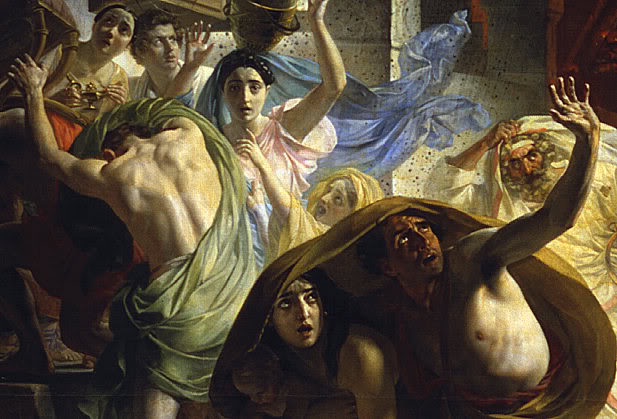Russian Art
Briullov, K. P.
"Last Day of Pompeii, Detail". 1833
Notes: Detail from "The Last Day of Pompeii"
"The Last Day of Pompeii" created a sensation when exhibited in Rome at the Roma Exhibition of 1833. With its ambitious, multi-figured scene, dramatic action, and wealth of detail, the painting changed the course of Russian history painting, inspiring others to attempt similarly complex compositions. One of the leading Italian artists of the day, Vincenzo Camuccini, proclaimed it a "flaming colossus," and it was the talk of the city. When the work was subsequently shown in Milan, Briullov was carried through the streets of the city on the shoulders of admiring fans.
Commissioned by Count Demidoff, who also patronized other Romantic-period artists, "The Last Day of Pompeii" was really not a Romantic canvas in the way that Delacroix's canvases were. Unlike the French painter's "The Algerian Women," which hung next to Briullov's painting at the Salon of 1834, the young Russian's tour-de-force displayed Classical figure types. This choice alone caused the French to view the painting as somewhat retardataire. Nevertheless, the salon jury awarded Briullov the First Gold Medal.
In preparing this monumental canvas, a process which took three years, Briullov insisted on historical accuracy. He visited the ruins of the ancient city (which was being excavated at the time he conceived the painting), studied artifacts of everyday life at the Naples Museum, and read Pliny the Younger's account of the eruption of Vesuvius. He even portrayed Pliny with his mother in the painting, interpreting a passage from the writer to the Roman historian, Tacitus: "Then my mother began to plead, to beg, to persuade, and at last to order me to flee . . . I, being a youth, will succeed; she, bearing the weight of her years and illnesses, would die in peace, knowing she hadn't held me back and caused my death."
Many of Russia's greatest writers and musicians responded enthusiastically to "The Last Day of Pompeii." Pushkin celebrated the work in verse. Herzen, the great Russian intellectual, argued that Briullov took the moral inspiration for the painting from the tragic events of December 1825, when a group of anti-autocratic intellectuals and aristocrats in St. Petersburg failed in their attempt to overthrow the government, which, in response, became even more reactionary. Gogol, however, claimed the work asserted man's heroism and dignity, calling it "a feast for the eyes" and proclaimed Briullov "a genius."
It is of interest to note that Briullov's painting and its fame are rarely discussed in Western texts on the history of Romanticism.

